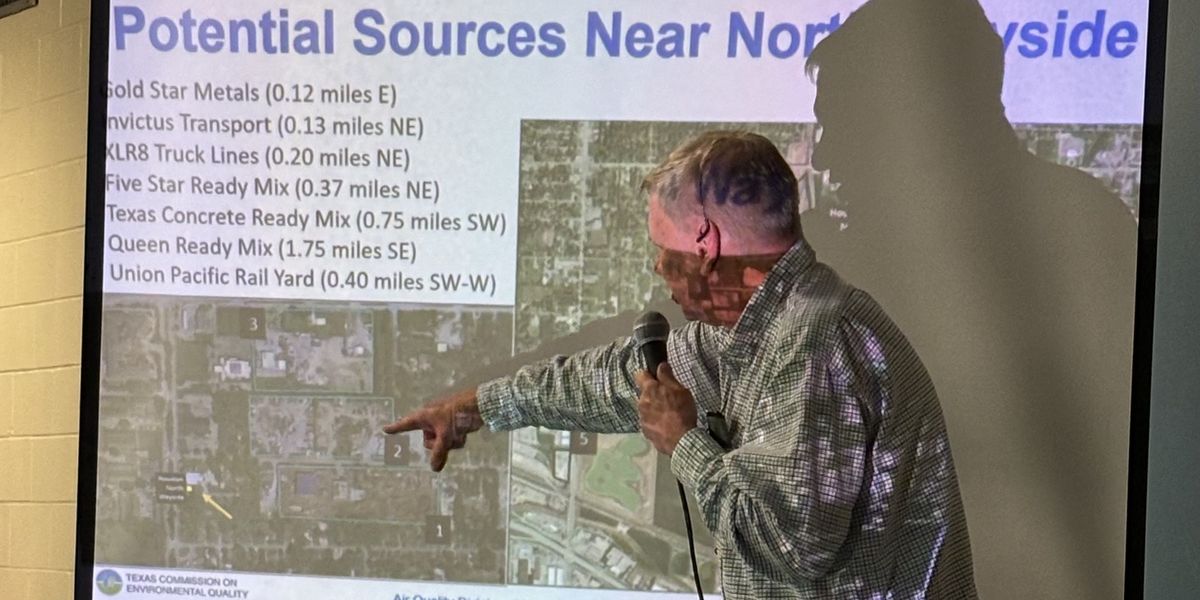
HOUSTON — Tuesday evening, the Texas Commission on Environmental Quality (TCEQ) told residents, activists and city officials from Houston’s Wayside neighborhood that nearly 70% of the time their air quality is worse than new federal regulations allow.
From July 2022 through June 2023, the TCEQ conducted a PM2.5 study in Houston’s Wayside neighborhood, which is predominantly Latino and surrounded by industry.
In Tuesday’s meeting, they shared their findings with community members. TCEQ Technical Specialist Eric Gribbin led the meeting by summarizing the PM2.5 samples and the data collected. PM2.5 is particulate matter smaller than a strand of human hair that can enter the bloodstream and cause adverse health effects like asthma attacks, premature death and others. A recent study named Houston the sixth worst city in the U.S. for PM2.5 pollution.
The TCEQ data found that the Wayside monitor measured 12.6 micrograms per cubic meter of PM2.5 over the year period – 3.6 micrograms per cubic meter higher than allowed under a new annual standard from the U.S. Environmental Protection Agency (EPA).
“On 56% of the days, PM2.5 pollution exceeded the prior standard of 12 micrograms per cubic meter and on 68.3% of measured days, PM2.5 was higher than 9 micrograms per cubic meter,” said Gribbin.
Gribbin noted that the data shows there are eight sources in the area as the largest contributors to the PM2.5 pollution, but said facilities could not be pinpointed at an individual level.
“There’s just too many facilities and possibilities to use this data as a ‘smoking gun’ for regulation,” Gribbin added.
Audience members voiced their health concerns.
“You can tell from being here that the community is informed,” Jacquita Johnson, public health student of Texas A&M University, said. “So, what about permitting?”
Questions like Johnson’s echoed in the room: “How will you process permit renewals?” or “Will you keep permitting these facilities we know are polluting PM2.5 when we are not in attainment?” The TCEQ representatives noted that their positions have no connections to the permitting divisions and could not answer questions about the permitting process.
“I can tell you what you probably already know, that facilities that apply for permits will use the new EPA PM2.5 standards in their air modeling,” Deputy Director of the air quality division of the TCEQ Donna Huff said.
“It’s a slap in the face,” said Northeast Houston resident Kourtney Revels. “It’s frustrating for you [the TCEQ] to come out and no one on your team can answer our questions.”
Houston’s complicated history of air monitoring has often resulted in monitors being spread too far apart, or too distant from emitters to accurately measure pollution, according to the Environmental Defense Fund. The TCEQ placed the monitor in Wayside in 2021 in response to this criticism.
The TCEQ plan shared by Gribbin shows that the TCEQ will propose their initial attainment designations by Feb. 2025 and that preliminary designations by the EPA would be set in March of 2026. Additionally, the EPA notes “the earliest that states would likely need to come into attainment is 2032.”
“We don’t know what control strategies look like at this time,” Huff said.
“I expected more actionable results,” said Johnson. “We know the data and the numbers. You [the TCEQ] can’t come in here and [fool] us. You limited our questions and time. There was a clear lack of effort.”
